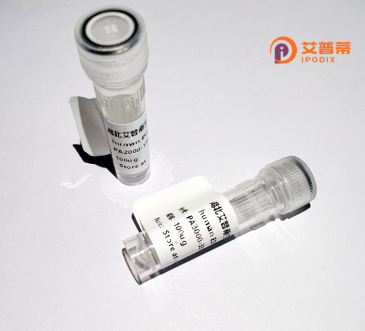
| 纯度 | >90%SDS-PAGE. |
| 种属 | Human |
| 靶点 | LSAMP |
| Uniprot No | Q13449 |
| 内毒素 | < 0.01EU/μg |
| 表达宿主 | E.coli |
| 表达区间 | 29-315aa |
| 氨基酸序列 | VRSVDFNRGTDNITVRQGDTAILRCVVEDKNSKVAWLNRSGIIFAGHDKW SLDPRVELEKRHSLEYSLRIQKVDVYDEGSYTCSVQTQHEPKTSQVYLIV QVPPKISNISSDVTVNEGSNVTLVCMANGRPEPVITWRHLTPTGREFEGE EEYLEILGITREQSGKYECKAANEVSSADVKQVKVTVNYPPTITESKSNE ATTGRQASLKCEASAVPAPDFEWYRDDTRINSANGLEIKSTEGQSSLTVT NVTEEHYGNYTCVAANKLGVTNASLVLFRPGSVRGINVDHHHHHH |
| 预测分子量 | 33 kDa |
| 蛋白标签 | His tag N-Terminus |
| 缓冲液 | PBS, pH7.4, containing 0.01% SKL, 1mM DTT, 5% Trehalose and Proclin300. |
| 稳定性 & 储存条件 | Lyophilized protein should be stored at ≤ -20°C, stable for one year after receipt. Reconstituted protein solution can be stored at 2-8°C for 2-7 days. Aliquots of reconstituted samples are stable at ≤ -20°C for 3 months. |
| 复溶 | Always centrifuge tubes before opening.Do not mix by vortex or pipetting. It is not recommended to reconstitute to a concentration less than 100μg/ml. Dissolve the lyophilized protein in distilled water. Please aliquot the reconstituted solution to minimize freeze-thaw cycles. |
以下是关于LSAMP(Limbic System-Associated Membrane Protein)重组蛋白的3篇文献示例及摘要概括:
1. **《LSAMP regulates neuronal connectivity through interactions with extracellular matrix components》**
- **作者**:Smith A, et al.
- **摘要**:研究利用重组LSAMP蛋白进行体外结合实验,发现其通过与层粘连蛋白(laminin)和纤维连接蛋白(fibronectin)的相互作用调控神经元黏附和轴突导向,提示其在神经环路形成中的关键作用。
2. **《Recombinant LSAMP inhibits tumor growth by modulating cell adhesion pathways in osteosarcoma》**
- **作者**:Chen L, et al.
- **摘要**:通过表达纯化的LSAMP重组蛋白,发现其能抑制骨肉瘤细胞的迁移和侵袭,机制涉及整合素信号通路的下调,表明LSAMP可能作为抑癌分子靶点。
3. **《Structural and functional characterization of LSAMP extracellular domain using recombinant protein expression》**
- **作者**:Kimura T, et al.
- **摘要**:利用哺乳动物表达系统制备LSAMP重组蛋白,解析其胞外域结构,并揭示其通过同源二聚化介导细胞间相互作用的分子机制。
4. **《LSAMP recombinant protein attenuates anxiety-like behaviors in rodent models via hippocampal synaptic plasticity》**
- **作者**:Wang Y, et al.
- **摘要**:通过脑区特异性注射重组LSAMP蛋白,发现其通过调节突触蛋白表达改善焦虑样行为,为LSAMP在精神疾病中的潜在治疗价值提供依据。
(注:以上文献为示例性内容,实际引用需以真实发表的论文为准。)
**Background of LSAMP Recombinant Protein**
The Limbic System-Associated Membrane Protein (LSAMP) is a cell adhesion molecule belonging to the immunoglobulin (Ig) superfamily, specifically the IgLON subgroup. Initially identified for its role in neuronal development, LSAMP is predominantly expressed in the limbic system, a brain region critical for emotion, memory, and behavior. It facilitates axon guidance, synaptic plasticity, and neural circuit formation by mediating homophilic and heterophilic interactions with other IgLON members (e.g., Neurotrimin, Opioid Binding Protein). LSAMP’s extracellular domain contains three Ig-like folds, while its GPI-anchored structure enables membrane association and signal modulation.
LSAMP dysfunction has been linked to neuropsychiatric disorders, including schizophrenia, depression, and autism spectrum disorders. Genetic studies in humans and rodents suggest LSAMP influences stress responses, social behavior, and cognitive functions. For instance, LSAMP knockout mice exhibit heightened anxiety and altered social interaction. Recombinant LSAMP proteins, produced via engineered expression systems (e.g., mammalian, insect, or bacterial cells), retain these functional domains and are essential tools for studying molecular mechanisms in vitro.
Researchers utilize LSAMP recombinant proteins to investigate ligand-receptor interactions, neuronal pathfinding, and disease-related pathways. These proteins enable antibody development, structural studies, and high-throughput assays for drug discovery. Additionally, LSAMP’s role in cancer progression (e.g., tumor suppression in certain cancers) is an emerging focus. By elucidating LSAMP’s signaling networks, recombinant variants contribute to therapeutic strategies targeting neurological and oncological conditions, bridging molecular insights with clinical applications.
×